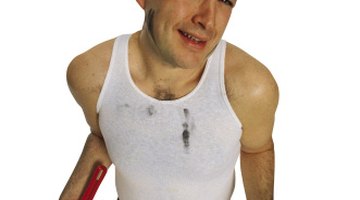How to Cap Water Lines
End caps glue on PVC water lines. There are two ways to cap a copper water line. (Water lines are apart from cast-iron water mains.) The easiest way for non-plumbers to cap a copper line is with a “Sharkbite” end cap made by the Cash Acme subsidiary of the Reliance Worldwide Corporation.

Things You Will Need
- Adjustable pipe cutter
- Metal file (for copper lines)
- PVC, Sharkbite or copper end cap (depending on your line and local plumbing code)
- PVC cement (for PVC lines)
- Heat gun (for soldered end caps)
- Flux paste (for soldered end caps)
- Wire solder (for soldered end caps)
- Propane torch (for soldered end caps)
- Matches (for soldered end caps)
- Wire brush (for soldered end caps)
Most hardware stores and home improvement centers sell Sharkbite fittings. They should be legal to install under your local plumbing code, but they might not be. So if you want to conscientiously adhere to all local plumbing codes, you may have to solder an end cap to your copper water line, and there is a little technique to that.
-
Turn off the water to your house at the main valve. Open all faucets.
-
Cut the line you want to cap with an adjustable pipe cutter. Remove any burrs from the end of cut copper lines with a metal file.
-
Glue a PVC end cap to PVC water lines with PVC cement. Push a Sharkbite end cap onto the end of cut copper lines where plumbing codes allow. Sharkbite fittings are self-adjusting and self-adhering.
-
Thoroughly dry the inside of cut copper lines that are to be fitted with soldered end caps using a heat gun. Steam prevents the proper installation of soldered end caps.
-
Clean the outside of the pipe and the inside of the end cap with emery cloth until both surfaces shine. Apply flux paste to the inside of the cap and to the cut pipe with your fingers. Slide the end cap over the end of the pipe.
-
Unroll about 3 inches of wire from a roll of solder wire. Light a propane torch with a match and adjust the gas flow until the torch flame is blue.
-
Heat the pipe and fitting with the torch. Touch the solder to all sides of the copper pipe when the flux begins to bubble. Ensure that the solder flows into the joint. If the solder does not flow into the joint, the pipe is still wet and steam is pushing the solder out.
-
Heat the end cap until the joint fills with solder and solder begins to accumulate outside the fitting. Remove excess solder with a wire brush.
-
Turn on the main water valve. Check the end cap for leaks.
-
Turn off all faucets. Recheck the end cap for leaks.
References
- “The Complete Guide to Plumbing”; Creative Publishing International; July 2008
- Home Improvement Zone; Soldering Copper Pipes; 2011
Writer Bio
Don Davis has been a professional writer since 1977. He has had numerous writing jobs, including writing news and features for the "Metrowest Daily News" and "Los Angeles Herald-Examiner." Davis has a Bachelor of Arts in English and history from Indiana State University.
Photo Credits
- Comstock/Comstock/Getty Images
- Comstock/Comstock/Getty Images
More Articles



